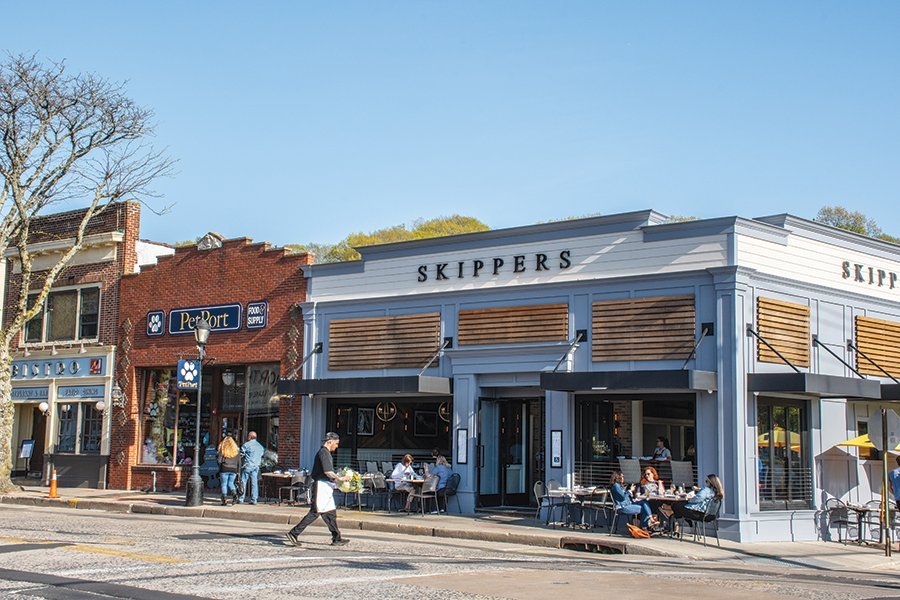Though separately owned, small businesses are intricately interdependent and interconnected.
For example, a study showed that for every dollar spent at The Paramount Huntington concert venue, $12 was spent at other businesses in the surrounding community, including restaurants, liquor shops and restaurant supply stores, notes Bob Fonti, co-chair of the Suffolk County Alliance of Chambers and co-chair of the Long Island Business Council.
“Small businesses are the backbone of the economy,” says Fonti. “They’re everything to the downtowns.
They create the economy. And, if you start looking at the bounce-back they have for other businesses, that’s what small businesses need.”
Adds Fonti, “Small businesses can be the rising tide to all businesses.”
An anchor for life on Long Island

Paramount Huntington concert venue, $12 was spent at
other businesses in the surrounding community. Photo by Judy Walker
Small businesses impact the economy, the community and the labor force, notes Eric Alexander, director of Vision Long Island, a regional smart growth planning organization. He is also the founder of Long Island Main Street Alliance, which works with 45 downtown communities, their chambers of commerce and elected officials throughout the island.
“It’s dollars, it’s jobs and it’s the community itself that benefits,” notes Alexander.
Long Island is a hyper-local place–a community of communities–making the uniqueness of each area a source of pride in its distinctive identity.
“We have something different in Rockville Centre than you have in Riverhead,” Alexander says. “There’s something different in Great Neck than there is in Greenport. And that’s to be championed.”
Compared with other regions, Long Island is more reliant on small business services than on chain stores and corporations, a fact that was demonstrated after the COVID-19 pandemic.
“A lot of our Main Streets held up better,” Alexander says. “We actually have lower vacancy rates in our downtowns because people are very loyal to their local businesses.”
Small businesses, which hire local people and utilize local vendors, are typically owned by those who live in the community who are usually very charitable to local causes.
“If you’re spending money at a small business, that money is getting recycled in the community,” Alexander says. “So, the lifecycle of funding of your dollar that goes into a small business really contains investment in your community.”
Small businesses contribute to village, town and county tax bases, which help fund our public schools and other services, and, simultaneously, also help keep the tax rate down for residents.”
He adds: “The healthier your downtown is with retail and office space, and even some ancillary industrial, you certainly are benefitting your bottom line because that commerce generates those dollars for all the services that people want in any community.”
From retail to restaurants and services, an emerging trend around the Island
is the growing number of minority-owned businesses, particularly Hispanic and South Asian, reflecting the diversifying population of the region, notes Alexander. This diversification is also reflected in the arts, culture, music, fairs and festivals, which consistently bring considerably more people and dollars into the region.
“Small businesses are really an anchor for life on Long Island,” Alexander says.
Small business: It’s who we are
Approximately 90 percent of Long Island’s 100,000-plus businesses are small businesses, says Matt Cohen, president and CEO of the Long Island Association.
“The large employers are utilizing small businesses as part of their operation and that benefits the entire economy here on Long Island,” says Cohen.
Between the pandemic, record inflation, high interest rates, supply chain disruptions and hiring shortages, the past few years were incredibly challenging to businesses here, which perpetually operate under stringent regulations in a high cost area, notes Cohen.
“And the small business community on Long Island has proven resilient,” he says.
Small business is not an abstraction. Rather, it’s personified by your local stationery store or your neighbor, who owns a nearby restaurant or dance studio.
“These are all real Long Islanders, and it’s so important to support our small business community here and shop local and to do what we can to really patronize small businesses, because it’s not only the backbone of our economy; it’s not only 100,000 businesses. These are our friends and family,” Cohen says. “It is who we are.”

communities–making the uniqueness of each area a
source of pride in its distinctive identity. Photo by Judy Walker
Chambers of commerce & small business: a symbiotic relationship
“The local chambers support the small businesses,” says Frank Camarano, president of Nassau Council of Chambers of Commerce.
Understanding that larger businesses, by nature, have more resources, chambers provide the resources that smaller businesses lack.
“By sticking together and working together, not only does that create a network, but the pooled resources can get more done,” Camarano says.
For communities lacking a downtown and lots of foot traffic, chamber events help draw people to the area.
Working at the grassroots level, local chambers serve as the liaison between communities and businesses, staying attuned to what the community needs, whether it’s a bakery, dry cleaner or some other small shop or service.
“What better way to get help and to help each other than through folks in your community?” says Camarano.
Whether businesses are members or not, the chamber benefits all the businesses through programs and events that bring people into the community.
Small businesses, mostly through their local chambers, also provide scholarships to students and other contributions to community members, notes Camarano.
Unlike other organizations, chambers, through their resources and relationships within local areas, help galvanize the revitalization of communities.
“This is the United States and things get driven by capitalism,” he adds. “Chambers are business organizations and by nature, if they’re functioning properly, they can get more done.”













